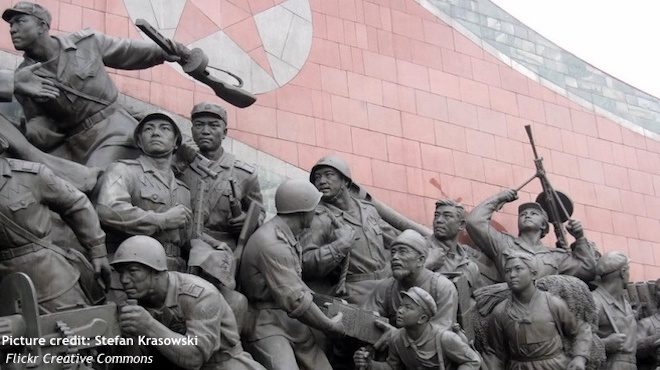The Fifth Nuclear Test: Weapons first, Negotiation later

In light of North Korea’s fifth nuclear test, Dr. Sangsoo Lee delves into Pyongyang’s greater strategy.
Late last week, the US Geological Survey detected a 5.3-magnitude earthquake in the area of North Korea’s Punggye-ri underground test site at about 9 a.m. local time on the 9th of September. Four hours later, North Korean state television announced that it had successfully detonated a nuclear warhead. Based on the seismic waveforms, the blast is estimated to have been about 10 kilotons, more than twice as large as the recent test in January and is the most powerful test conducted so far by North Korea.
A more significant revelation from the test is the rapid progress that North Korea has made in developing their nuclear technology. According to the Korea Central News Agency (KCNA), the test “finally examined and confirmed the structure and specific features of movement of [a] nuclear warhead that has been standardised to be able to be mounted on strategic ballistic rockets.” Furthermore, KCNA explained that standardization of a nuclear warhead, “will enable the DPRK to produce at will and as many as it wants a variety of smaller, lighter and diversified nuclear warheads of higher strike power”.
North Korea’s fourth test in January 2016 came with an unconfirmed claim that their technology had progressed to the point of developing a hydrogen bomb. Regardless of their H-bomb capacity, or ability to standardize warheads it is clear that North Korea already possess a closed technology, or, at the very least will have such capacity very soon.
US-China Tensions
North Korean nuclear tests must be understood within the context of already highly tense US-China relations. The current debate over the South China Sea and cybersecurity are among a host of issues which have caused great strains between the two superpowers. Although Beijing has agreed to implement sanctions against North Korea, they have consistently opposed applying the tougher sanctions that the US and others have called for.
Aside from sanctions, the US has responded to the previous tests by staging a large-scale joint military exercise and the deployment of the THAAD missile defense system which enhances defense cooperation with South Korea (and Japan). However, these measures have been viewed by Beijing as a means for the US to enhance their strategic assets in the region. As the situation with North Korea develops, instead of dealing directly with North Korea, China may instead counter US policy by increasing its own strategic assets in Northeast Asia. Indeed, the ceaseless posturing between the US and China allows North Korea a great deal of political leverage to conduct nuclear tests.
A New Negotiation Strategy
When we consider North Korea’s nuclear test records of the past; 2006, 2009, 2013 and 2016 (in January), the regime conducted their nuclear test roughly every three years. During this period the tests were used by North Korea to strengthen their position in negotiations. They demanded that the US provide them with humanitarian and financial aid, energy assistance, cease US-ROK military exercises and to sign a peace treaty as a precondition to discuss the issue of denuclearization. The restarting of the Yongbyon experimental nuclear reactors in March 2013 signaled a change. This allowed North Korea to modify their strategy and produce greater stockpiles of nuclear materials enabling more tests and accelerated their testing program.
This has also meant that the more recent tests have been absent from previous demands. Presently, North Korea has next to no interest in receiving economic assistance nor even security assurances for their de-nuclearization. Rather, after realizing that there will be no change to the US government policy of ‘strategic patience’ (a policy by which the US would wait for North Korea to decide to de-nuclearize) North Korea is pursuing a strategy of ‘nuclear development first, negotiations later’. Such a platform would allow North Korea a stronger position from which to negotiate as a State that possess nuclear weapons. Washington’s imminent presidential transition presents a unique opportunity for Pyongyang. Both the incoming president and a “lame-duck” Obama will be unable to take any military measures such as striking North Korea’s nuclear facilities.
Accordingly, it is likely that North Korea will conduct additional tests this year and make further progress towards a national nuclear program. In order to truly show that their nuclear capacity is a real threat to the US, these tests would most likely involve a stronger amplification factor and an intercontinental ballistic missile with a standardized nuclear warhead.
The Obama administration stated that the latest nuclear test will not lead it to a change of its assessment of North Korea’s overall ‘nuclear and military capabilities’. However, North Korea will eventually reach nuclear capacity, in which case, the US must take real action through either negotiation or a military intervention. In light of North Korea’s updated strategy, the incoming US president should re-think and reassess ‘strategic patience’.
Additionally…
We sat down with Dr. Lars Vargö, Distinguished Fellow at ISDP, and former Ambassador to Japan and South Korea, to find out his views on Japan’s reaction to the test. Watch the video here.